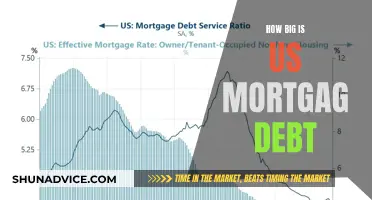
The evolution of the mortgage market has been a gradual process, shaped by changing demographics, economic crises, and government interventions over time. The modern mortgage market began to take shape after the Great Depression in the 1930s, when the US government intervened to promote homeownership and stabilize the market. This period saw the introduction of government-backed programs, mortgage refinancing, and the Federal Housing Administration, which offered long-term, fully amortized loans with lower down payment requirements, making homeownership more accessible. The post-World War II era further transformed the market with the introduction of low-interest VA loans for veterans, leading to a significant increase in homeownership rates. However, the mortgage market has continued to evolve, facing challenges such as the ageing population, the need for innovation in products catering to older borrowers, and the impact of the 2007-2008 financial crisis, which led to new rules and self-correction in the industry.
What You'll Learn

The early history of mortgages
The concept of a mortgage is not new and can be traced back to ancient civilizations. In its most basic form, a mortgage is an agreement between a lender and a borrower, where the lender exchanges property with the borrower, with the borrower pledging to repay the loan over time. While this concept has endured, the specifics of mortgages have changed drastically over time.
In the 14th century, mortgages in France were very different from modern home loans. Charging interest on loans was not legal until the early 16th century, and there was no concept of the borrower's right of redemption. Before the 20th century, mortgages were largely unregulated. Cash loans were typically provided by banks to farmers to purchase land, although wealthier families could also borrow money to buy property.
The modern mortgage market began to take shape in the 1930s and 1940s, with the introduction of government-backed programs to encourage lenders to make home loans more accessible. During the Great Depression, many borrowers defaulted on their loans, and banks struggled with limited funds and resources. In response, the US government, under President Franklin D. Roosevelt, introduced The New Deal, which included the Home Owners' Loan Act, providing emergency relief for mortgage debt and introducing the concept of mortgage refinancing. The Federal Housing Administration (FHA) was also created to give lenders confidence to lend again, with FHA-backed mortgages offering long-term, fully amortized loans with low down payment requirements, making homeownership more attainable for a wider range of Americans.
The post-World War II era saw a further boost in homeownership, with the introduction of low-interest VA loans for veterans, leading to an 8% increase in homeownership rates between 1940 and 1960. However, the mortgage market at this time was not equitable, with discrimination and segregation against borrowers of color being common.
ARM Mortgages: Are They Still Popular?
You may want to see also

The impact of the Great Depression
The Great Depression, lasting from 1929 to 1939, was a period of severe economic turmoil that had a profound impact on the mortgage market. Millions lost their jobs, homes, and savings, leading to widespread poverty and desperation. The crisis was triggered by a combination of factors, including a decade-long economic boom, speculative investments, and a banking crisis. The stock market crash of 1929, known as Black Tuesday, wiped out millions in wealth, triggering a chain of events that led to widespread economic hardship.
In response to the crisis, the federal government intervened to provide support and stability to the mortgage market. The Roosevelt Administration created the Home Owners' Loan Corporation (HOLC) in 1933, which purchased and refinanced over 1 million delinquent home loans over the next three years. The HOLC's appraisals were relatively high, and it has been argued that they were inflated to keep lending institutions solvent, which came at the expense of homeowners. The federal government also created the Federal Housing Administration (FHA) in 1934, which insured mortgages that met specific criteria and set restrictions on terms and interest rates. These measures helped to stabilise the housing market and prevent a complete collapse.
The Great Depression led to a paradigmatic shift in mortgage lending, with a shift towards longer-term maturity, fully amortizing mortgages, and the creation of a thick secondary market for mortgage-related securities. The federal government's response to the crisis set a precedent for government intervention in the housing market and shaped the way we approach mortgages and homeownership today. The New Deal's Wagner-Steagall Housing Act of 1937 was a significant development, as it marked the first time the federal government recognised housing as a social need. This led to initiatives to provide permanent housing for the most disadvantaged members of society.
The Mortgage Bond Market Crash of 2008: A Postmortem
You may want to see also

Post-WWII mortgage innovations
The post-World War II period saw significant innovations in the mortgage market, with Congress passing several laws to promote homeownership. These initiatives helped create government-backed programs that encouraged lenders to offer home loans to a wider range of people. This period also witnessed the emergence of the modern mortgage market, which looked quite different from its historical counterparts.
The 1930s and 1940s marked a critical phase in the evolution of the mortgage industry. The National Housing Act of 1934, enacted as part of the New Deal, played a pivotal role in this transformation. This legislation brought about the establishment of two key agencies: the Federal Housing Administration (FHA) and the Federal Savings and Loan Insurance Corporation (FSLIC).
The FHA insured mortgages that met specific criteria, while the FSLIC insured deposits at S&Ls (Savings and Loan Associations). Both organisations worked towards stabilising the housing market by increasing the availability of credit, thus bolstering the market and stabilising home prices. The FHA also imposed restrictions on the terms and interest rates of qualifying mortgages, typically requiring fully amortising mortgages with longer-term maturities and interest rates exceeding 5% annually only in rare cases.
The Federal Government also created the Federal National Mortgage Association (FNMA), often known as Fannie Mae. This entity purchased mortgages issued under the FHA's auspices, fostering a substantial secondary market for residential mortgages. These measures collectively contributed to the evolution of the mortgage market, making it more accessible and stable for borrowers.
Additionally, the post-WWII era saw the introduction of reverse mortgages, which have since become a trusted financial planning tool for older homeowners. These mortgages have undergone refinements to ensure borrower protection; for instance, borrowers must now meet minimum residual income guidelines to qualify. The One-Time Close loan option is another innovation, simplifying the process for buyers of manufactured homes by consolidating construction and permanent loans into a single loan with one closing.
Bush's Legacy: Lowering Mortgage Standards, Raising Risks
You may want to see also

The evolution of the secondary mortgage market
The modern mortgage market began to take shape after the federal government intervened during the Great Depression. This intervention resulted in the formation of the Federal Housing Administration (FHA), the Federal National Mortgage Association (Fannie Mae), and the Home Owner's Loan Corporation (HOLC). The Great Depression caused property values to plummet, which destabilized the mortgage market. As a result, in 1929, the growing mortgage debt, combined with lagging home values, played a key role in the bursting of the housing bubble and the stock market crash. With many borrowers unable to make their mortgage payments and unable to resell their property due to plummeting home values, millions of Americans were at risk of foreclosure in the 1930s.
The FHA was created as part of the National Housing Act of 1934 to give lenders the confidence to lend again. All FHA-backed mortgages were long-term (20 to 30 years) fully amortized loans and required as little as a 10% down payment. These terms were attractive to borrowers, leading other private institutional lenders to adopt similar mortgage structures to remain competitive. The HOLC was responsible for keeping people in their homes through the introduction of the concept of mortgage refinancing.
Following World War II, a new generation was ready to settle down and buy homes. Some had the added help of newly instated, low-interest VA loans derived from the G.I. Bill for veterans, resulting in a major hike in homeownership across the country. Up to this point, mortgage lending was not particularly fair or equitable, with discrimination and segregation against borrowers of color being common.
As the baby boomers grew into adults in the 1970s and pursued homeownership, Congress realized that the secondary market where MBS were traded lacked sufficient capital to finance the younger generation's purchases. In response, Congress chartered a second GSE, the Federal Home Loan Mortgage Corporation, also known as Freddie Mac. Congress privatized Fannie in 1968, and in 1970, both Fannie and Freddie were authorized to purchase conventional loans.
In the early 2000s, the secondary mortgage market saw increasing growth in private-label securities, which were not issued by one of the GSEs. These securities were backed by mortgages that did not necessarily adhere to the same standards as those purchased by the GSEs. As a result, Freddie and Fannie, as profit-seeking corporations, were under pressure to increase returns for their shareholders, and they added these riskier private-label MBS to their own investment portfolios.
What Are the Chances of Assuming a Mortgage?
You may want to see also

The future of the mortgage market
Technological advancements will continue to play a pivotal role in the mortgage market's evolution. The increasing adoption of digital tools, resources, and emerging trends will shape the industry. Online platforms and digital mortgage brokers will become more prominent, offering efficient services and enhanced customer experiences. The utilization of data analytics and artificial intelligence will improve risk assessment, underwriting processes, and loan personalization.
Regulatory changes and industry innovations will also be key factors. The mortgage market will continue to adapt to new rules and policies aimed at protecting consumers and promoting financial stability. The industry will likely witness the emergence of new mortgage products and services designed to cater to diverse consumer needs, especially those of older borrowers and individuals with varying financial backgrounds.
Demographic shifts, including an aging population and changing borrower profiles, will influence the types of mortgage products offered. There will be a growing demand for innovative solutions that bridge the gap between traditional mortgages and lifetime mortgages, addressing the needs of older individuals and those seeking to release equity from their properties.
Additionally, the mortgage market will need to adapt to changing homebuyer preferences and market dynamics. The rise of remote work and shifting lifestyle choices may impact the demand for specific types of properties or locations. The industry will need to remain agile and responsive to these evolving preferences to ensure sustained growth and accessibility in homeownership.
Mortgage Brokers: Surviving the Bubble Burst and Beyond
You may want to see also
Frequently asked questions
A mortgage agreement allows an individual to borrow money to purchase a home, which is then repaid to the lender with interest.
The modern mortgage market began to take shape after the federal government intervened during the Great Depression. The Home Owners' Loan Act, part of President Franklin D. Roosevelt's New Deal, provided emergency relief for mortgage debt and introduced the concept of mortgage refinancing. The Federal Housing Administration (FHA) was also created to give lenders the confidence to lend again through several innovations. The FHA-backed mortgages were long-term, fully amortized loans with low down payment requirements, which were attractive to borrowers and encouraged other lenders to adopt similar structures.
The American mortgage market has its roots in the founding of the first legitimate commercial bank in 1781. The number of banks increased between 1820 and 1860, leading to an increase in the volume of loans. The National Bank Act of 1864 established national bank charters and created greater security for the federal treasury. The modern American mortgage market dates back to the 1930s and 1940s when Congress passed several laws to promote homeownership and encourage lenders to make home loans more accessible. Post-World War II, the introduction of low-interest VA loans for veterans resulted in a significant increase in homeownership.
One challenge is catering to an ageing population. With people living longer, pensions need to last longer, and there is a risk of consumers not being able to repay their mortgages before retirement. This has led to the development of Lifetime Mortgages and other innovative products to bridge the gap between traditional mortgages and the needs of older borrowers. The mortgage market is also constantly evolving to keep up with changing homebuying habits and preferences, and to adapt to new technologies.







